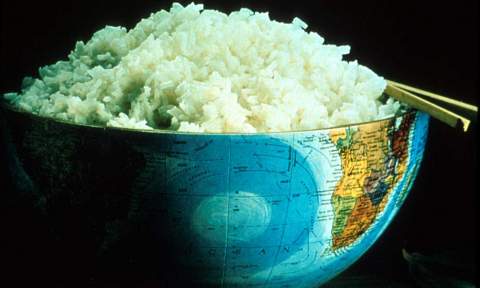Let
Them
Eat Rice
Jill Richardson OP ED Published April 12, 2014
The gusher of money, time and resources wasted on one genetically engineered crop imbued with a single vitamin could have solved some easier-to-fix problems behind worldwide hunger.
A recent Scientific American blog post blamed environmentalists for costing poor, malnourished people an estimated 1,424,000 life years in India alone. Why? Because they presumably kept Golden Rice off the market for over a decade when it could have been helping the world’s poor during that time.
Golden Rice contains beta-carotene, a precursor of vitamin A. Rice doesn’t normally contain beta-carotene. Golden rice was created by genetic engineering: Scientists inserted genes from another species into its DNA.
According to that post by David Ropeik, Golden Rice was ready to go back in 2002, if it weren’t for those meddling tree-huggers. But, back then, you’d have to eat 20 pounds of the rice every day just to get a sufficient amount of vitamin A in your diet from it.
That said, after visiting peasant farmers on four continents, I’ve got a new perspective on hunger, malnutrition, and Golden Rice’s potential.The technology has since improved. Now, someone could actually obtain their needed vitamins by eating a realistic amount of the colorful rice. But it’s dishonest to claim that lives were lost or harmed by not eating Golden Rice starting in 2002.
When I travel, I always ask families what they eat. In the Philippines, without fail, every family responded, “Rice.”
Just rice? An entire diet of rice? Hmm, maybe they need that Golden Rice.
Just rice? An entire diet of rice? Hmm, maybe they need that Golden Rice.
Eventually, I tried a new approach: “What do you eat with your rice?”
In Kenya, I’ve visited areas where the staple was white corn, not rice. Yet, like rice, white corn is not known for its abundance of vitamin A. But nobody I’ve met eats just corn. They eat beans, kale, pumpkin, sweet potatoes, and an abundance of African greens. You see kale growing all over, even in urban slums. And it contains about two and a half times as much vitamin A as Golden Rice.
Vitamin A isn’t rare in food. And it’s not the only nutrient that malnourished people worldwide lack.
The malnourished people I met in my travels did not only lack this nutrient or that one – they simply lacked food. Like a Kenyan school where many kids did without breakfast and lunch every day. Some had to work in a quarry after school just to earn money to eat. Good bet those kids needed vitamin A — and every other vitamin, mineral, protein, fat, and just plain old calories.
Golden Rice isn’t the best solution in such cases. It’s solving the root causes of poverty and hunger. That means ending injustice and corruption, providing access to water, secure land tenure, and birth control, taking on the climate crisis, and dealing with HIV/AIDS, among other things.
Big Ag and biotech firms spent more than two decades developing Golden Rice. That gusher of money, time, and resources could have solved some of the broader, overarching, and easy-to-fix problems peasant farmers face.
By focusing on the real, underlying problems instead of a narrowly defined nutrient deficiency, countless numbers of people could have enjoyed a higher standard of living.
Instead, biotech companies and people like Ropeik, who has ties to the biotech industry, attempt to reframe the debate as one about Golden Rice.
Golden Rice is simply a distraction the biotech industry dreamed up. It’s an expensive, non-solution to a serious problem and it’s merely designed to improve the image of other controversial genetically engineered crops in bigger markets, including the United States.

No comments:
Post a Comment